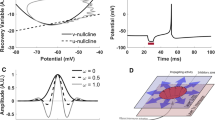Summary
Spontaneous activity and rhythmical oscillations are common features of large neuronal networks in mammals. Detection of repetitive spike patterns or pacemaker activity during electrophysiological recording of spontaneous action potentials from single neurons can be difficult if a “noisy” background is present. This paper describes an improved method for an online spike train analysis based on joint interval histograms (JIH, Rodiek et al. 1962). By means of higher ordered JIH the discrimination of spike patterns with repetitive bursting activity or oscillations is possible even when randomly distributed action potentials appear. Examples of simulated spike trains and those recorded from cultured hippocampal neurons are presented.
Similar content being viewed by others
References
Awiszus F (1989) On the description of neuronal output properties using spike train data. Biol Cybern 60:323–333
Bland BH, Andersen P, Ganes T, Sveen O (1980) Automated analysis of rhythmicity of physiologically identified hippocampal formation neurons. Exp Brain Res 38:205–219
Brink F, Bronk DW, Larabee MG (1946) Chemical excitation of nerve. Ann NY Acad Sci 47:457–48
Colquhoun D, Hawkes AG (1983) The principles of the stochastic interpretation of ion-channel mechanisms. In: Sakmann B, Neher E(eds) Single-channel recording. Plenum Press, New York London, pp 135–174
Dayhoff JE, Gerstein GL (1983) Favored patterns in spike trains. I. Detection. J Neurophysiol 49:1334–1348
Habets AMMC, Van Dongen AMI, Van Huizen F, Corner MA (1987) Spontaneous neuronal firing patterns in fetal cortical networks during development in vitro: a quantitative analysis. Exp Brain Res 69:43–52
Hammill OP, Marty A, Neher E, Sakmann B, Sigworth FJ (1981) Improved patch-clamp techniques for high resolution current recordings from cells and cell-free membrane patches. Pflügers Arch 391:85–100
Herz A, Creutzfeldt O, Fuster J (1964) Statistische Eigenschaften der Neuronaktivität im ascendierenden visuellen System. Kybernetik 2:61–71
Holden AV, Ramadan SM (1980) Identification of endogenous and exogenous activity in a Molluscan neurone by spike train analysis. Biol Cybern 37:107–114
Köller H, Siebler M, Schmalenbach C, Müller HW (1990) GABA and glutamate receptor development of cultured neurons from rat hippocampus, septal region and neocortex. Synapse 5:59–64
Köller H, Siebler M, Schmalenbach C, Müller HW (1990) Electrophysiological properties of septal region neurons during development in culture. Brain Res 509:85–90
Köller H, Siebler M, Schmalenbach C, Müller HW, Freund HJ (1989) Synaptic connections in a network of cultured hippocampal neurons. Eur J Physiol Suppl (1)413:80
Lange DG, Hartline PH (1979) Fourier analysis of spike train data. Biol Cybern 34:31–34
Lansky P, Radii T (1987) Statistical inference on spontaneous neuronal discharge patterns. I. Single neuron. Biol Cybern 55:299–311
Liu L (1989) A method of neuronal spike train study based on autoregressive analysis. Biol Cybern 61:289–293
Matthiessen HP, Schmalenbach C, Müller HW (1989) Astrogliareleased neurite growth-inducing activity for embryonic hippocampal neurons is associated with laminin bound in a sulfated complex and free fibronectin. Glia 2:177–188
Müller HW, Seifert W (1982) A neurotrophic factor (NTF) released from primary glial cultures supports survival and fiber outgrowth of cultured hippocampal neurons. J Neurosci Res 8:195–204
Perkel DH, Gerstein GL, Moore GP (1967) Neuronal spike trains and stochastic point processes. Biophys J 7:391–440
Rodieck RW, Kiang NY-S, Gerstein GL (1962) Some quantitative methods for the study of spontaneous activity of single neurons. Biophys J 2:351–368
Schild D (1983) A note on the use of serial measures in spike train analysis and their relation to corresponding moments. Int J Neurosci 18:247–252
Segal M (1983) Rat hippocampal neurons in culture: responses to electrical and chemical stimuli. J Neurophys 50:1249–1264
Shao XS, Chen PX (1987) Normalized auto-and cross-covariance functions for neuronal spike train analysis. Int J Neurosci 34:85–95
Siebler M, Köller H, Schmalenbach C, Müller HW, Freund HJ (1988) Patterns of spontaneous activity in cultured networks of hippocampal and septal neurons. Abstr Soc Neurosci 14: -104.3
Siebler M, Köller H, Schmalenbach C, Müller HW (1989) GABA activated chloride currents in cultured rat hippocampal and septal region neurons can be inhibited by curare and atropine. Neurosci Lett 93:220–224
Siegel RM (1990) Non-linear dynamical system theory and primary visual cortical processing. Physica D 42:385–395
Author information
Authors and Affiliations
Rights and permissions
About this article
Cite this article
Siebler, M., Köller, H., Rose, G. et al. An improved graphical method for pattern recognition from spike trains of spontaneously active neurons. Exp Brain Res 90, 141–146 (1992). https://doi.org/10.1007/BF00229265
Received:
Accepted:
Issue Date:
DOI: https://doi.org/10.1007/BF00229265




